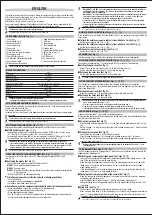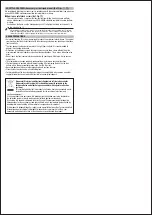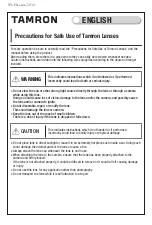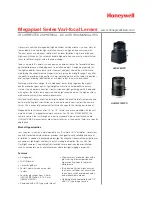
ENGLISH
Thank you for purchasing this Tamron lens. Before using your new lens, please read the contents
of this Owner’s manual to properly use the lens. Also, it will be important to read the manual of the
camera to which you will attach the lens.
After reading, store this Owner’s manual in a safe place.
Please read also the document “Precautions for Safe Use of Tamron Lenses” supplied with the
lens for the detailed safety precautions to observe when using Tamron lenses.
•
Explains precautions that help to prevent problems.
•
Explains things you should know in addition to basic operations.
PART NAMES (Refer to Fig. )
①
Lens hood
②
Hood attaching alignment mark
③
Hood locking mark
④
Filter ring
⑤
Hood release mark
⑥
Zooming ring
⑦
Focal length scale
⑧
Focal length mark
⑨
Focus ring
⑩
Tripod mount
⑪
Tripod mount mark
⑫
Tripod mount locking screw
⑬
Screw hole for safety lock screw
⑭
Safety lock screw (×2)
⑮
Hexagonal wrench
⑯
Strap hole
⑰
Lens attachment mark
⑱
AF/MF switch
⑲
VC (Vibration Compensation) switch
⑳
VC mode switch
㉑
Focus limiter switch
㉒
Lens-camera interface contacts
㉓
Wide-end zoom lock switch
•
Before using the lens, make sure to remove the tape on lens surface.
MAIN SPECIFICATIONS
Model
A057
Focal Length
150-500 mm
Maximum Aperture
F/5-6.7
Angle of View (diagonal)
16˚25' - 4˚57'
Optical Construction
16/25
Minimum Focus Distance (MOD)
0.6 m (23.6") (Wide) / 1.8 m (70.9") (Tele)
Maximum Magnification Ratio
1:3.1 (Wide MOD) / 1:3.7 (Tele MOD)
Filter Size
ø 82 mm
Length
209.6 mm (8.3")
Maximum Diameter
ø 93 mm
Weight
1,725 g (60.8 oz) (without tripod mount) / Tripod mount 155 g (5.5 oz)
Lens Hood
HA057
•
Length : From tip of front element to mount surface.
•
Specifications, appearance, functionality, etc. are subject to change without prior notice.
ATTACHING AND REMOVING THE LENS
Remove the rear cap of the lens. Align the lens attachment mark
⑰
and mounting mark on the
camera, and then insert the lens.
Turn the lens clockwise until it locks.
To remove the lens, turn the lens in the opposite direction while pressing the lens release button
on the camera.
•
Turn off the power of the camera before attaching or removing the lens.
•
For details, please read the instruction manual of your camera.
SWITCHING FOCUS MODE (Ref. Figs. , )
Selection of focus mode is done using the camera and the AF/MF switch
⑱
on the lens.
■
AF/MF Switching (Ref. Figs. , )
To shoot using autofocus (AF), set both the camera and the AF/MF switch
⑱
on the lens to
“AF”. (Ref. Fig. ) (If the lens is set at “MF”, it will not autofocus.)
To shoot using manual focus (MF), set the camera and/or the lens AF/MF switch
⑱
to “MF”.
For manual focus, turn the focus ring
⑨
to acquire the focus. (Ref. Figs. , )
•
Under AF mode, there may be difficulty for autofocus to work depending on the subject.
•
If your camera features an AF/MF control button, it is possible to temporarily switch to MF from
AF, by pressing the AF/MF control button. When the lens set to “AF” and the camera set to “MF”,
by pressing the AF/MF control button you may temporarily switch the focus to AF.
•
For details, please read the instruction manual of your camera.
VIBRATION COMPENSATION MECHANISM (Ref. Figs. , , )
To compensate for the vibrations, set the VC (Vibration Compensation) switch
⑲
to ON.
(Ref. Fig. )
■
Switching the modes (Ref. Fig. )
You can switch the modes by using the VC mode switch
⑳
.
MODE 1
Basic vibration compensation mode
MODE 2
Panning mode
MODE 3
Mode that prioritizes framing. Makes it easier to maintain subjects moving quickly
within the frame.
* MODE 1 and MODE 3 do not support panning.
●
Vibration compensation is effective under the following conditions
•
Dimly lit locations
•
Locations where flash photography is prohibited
•
Locations where tripod cannot be used
●
Vibrations may not be compensated sufficiently under the following conditions
•
When a photograph is taken from a vehicle that is shaking greatly
•
Shooting during excessive movement of the camera
•
When shooting while using a tripod
•
Set the VC switch
⑲
to OFF when taking pictures with bulb photography (long exposures).
Otherwise, vibration compensation may cause a malfunction.
•
When MODE 1 or MODE 2 is set, the viewfinder image may become blurred immediately after the
shutter button is pressed halfway. This is due to the principles of the vibration compensation
mechanism and not a malfunction.
•
When MODE 3 is set, the viewfinder image may become blurred even without touching the shutter
button in the case the camera is turned on with the VC switch
⑲
set to ON. This is due to the
principles of the vibration compensation mechanism and not a malfunction.
•
Set the VC switch
⑲
to OFF when you are shooting while the camera is secured by something
other than your hand (such as a tripod).
•
You may feel the lens rattle when the camera is turned off or when the lens is removed from the
camera. This is not a malfunction.
•
For details, please read the instruction manual of your camera.
USING THE FOCUS LIMITER (Ref. Figs. , - )
When autofocus is set, switching the focus limiter switch
㉑
can speed up focusing by limiting the
focus range.
■
To limit the autofocus range to subjects from infinity to 3 m (Ref. Fig. )
Set the focus limiter switch
㉑
to “∞-3m”.
■
To limit the autofocus range to subjects from infinity to 15 m (Ref. Fig. )
Set the focus limiter switch
㉑
to “∞-15m”.
■
When not using the focus limiter (Ref. Fig. )
Set the focus limiter switch
㉑
to “FULL”.
ZOOMING (Ref. Fig. )
Turn the zooming ring
⑥
to adjust the focal length (Zoom position) to a desired position.
WIDE-END ZOOM LOCK MECHANISM (Ref. Figs. , , )
You can lock the zooming ring
⑥
at a focal length of 150 mm to keep it from rotating.
■
Setting the zoom lock (Ref. Fig. )
Align 150 mm on the focal length scale
⑦
with the focal length mark
⑧
.
Set the wide-end zoom lock switch
㉓
to the zooming ring side.
■
Releasing the zoom lock (Ref. Fig. )
Set the wide-end zoom lock switch
㉓
to the camera side.
•
To zoom, release the lock, and then rotate the zooming ring
⑥
.
FLEX-ZOOM LOCK MECHANISM (Ref. Figs. , , )
This mechanism is intended to stop the lens from zooming inadvertently at any position.
Rotate the zooming ring
⑥
to the desired zoom position, and then apply the lock after you have
determined the position.
■
Setting the zoom lock (Ref. Fig. )
Move the zooming ring
⑥
to the subject side until the white mark is visible.
■
Releasing the zoom lock (Ref. Fig. )
Move the zooming ring
⑥
to the camera side.
•
During activities such as carrying the product, use the wide-end zoom lock to prevent zooming
due to its own weight. (Ref. Figs. , )
•
To zoom, release the flex-zoom lock, and then rotate the zooming ring
⑥
.
•
Take care not to get your fingers caught while you switch the flex-zoom lock.
•
If the camera will not be used for an extended period, release the flex-zoom lock before storage.
LENS HOOD (Ref. Figs. , , )
A bayonet-type lens hood
①
is provided as standard equipment.
We recommend shooting with the hood properly attached because the lens hood eliminates stray
light that may affect the picture.
■
Using the lens hood (Ref. Fig. )
Align the hood attaching alignment mark
②
of the hood with the hood release mark
⑤
of the
lens.
Rotate the hood
①
in the direction of the arrow until the hood locking mark
③
meets the hood
release mark
⑤
.
■
Stowing the lens hood (Ref. Fig. )
You can stow the lens hood
①
by attaching it in reverse.
Align the hood locking mark
③
of the hood with the hood release mark
⑤
of the lens.
Rotate the hood
①
in the direction of the arrow until the hood attaching alignment mark
②
meets the hood release mark
⑤
.
•
Be aware that the periphery of the photographed image may be darkened if the hood
①
is not
attached properly.
TRIPOD MOUNT (Ref. Figs. , - )
The A057 model comes with a tripod mount
⑩
. When you use a tripod, lock the lens firmly to the
tripod using the tripod mount
⑩
.
■
Attaching and removing the tripod mount (Ref. Figs. , )
You can attach and remove the tripod mount by loosening tripod mount locking screw
⑫
and
then lift the portion with the screw, to open the ring.
When attaching the tripod mount, make sure that the protruding part on the inner side of the
tripod mount
⑩
is inserted into the groove on the lens, and then tightly secure the tripod
mount locking screw
⑫
.
If this protruding part is not inserted into the groove on the lens correctly when attaching the
tripod mount
⑩
, the lens may be damaged or fall off.
■
Changing the directional position of the camera (Ref. Fig. )
When you change the directional position of the camera, you can rotate the lens by loosening
the tripod mount locking screw
⑫
.
Align the tripod mount mark on the lens
⑪
with the mark on the tripod mount
⑩
.
After determining the shooting position, tightly secure the tripod mount locking screw
⑫
to fix
the position.
■
Strap hole (Ref. Fig. )
You may pass a strap through these holes to prevent the lens from falling.
When using the strap holes
⑯
of the tripod mount
⑩
, first check that the tripod mount locking
screw
⑫
is firmly tightened, and then attach the strap securely. Note that the lens may fall if
the tripod mount
⑩
or the strap detaches from the lens.
•
The A057 tripod mount
⑩
can be attached to an ARCA-SWISS camera platform.
SAFETY LOCK SCREW (Accessory for the tripod mount) (Ref. Figs. , )
We recommend attaching the lock screws in accordance with the camera platform type when you
use an ARCA-SWISS-standard compatible camera platform or clamp.
■
How to use safety lock screws (Ref. Fig. )
The safety lock screws
⑭
prevent the lens/camera from falling from the camera platform
when a tripod mount
⑩
is attached to an ARCA-SWISS-standard compatible camera platform
or clamp.
As shown on the figure, use the hexagonal wrench
⑮
to tighten the safety lock screws
⑭
to
the two screw holes
⑬
.
•
After attaching the safety lock screws
⑭
, the screw heads protrude from the tripod mount
⑩
bottom
surface to prevent the lens/camera from falling. For this reason, if you are using a camera platform or a
clamp other than ARCA- SWISS-standard compatible, you do not need to have them attached.
USAGE PRECAUTIONS
•
An internal focusing (IF) system is employed to reduce the minimum focus distance. The angle of
view may be wider than that of lenses with other focusing systems when shooting at a distance
less than infinity.
•
The lens hood or the lens barrel may block the light from the flash. It is recommended to
perform trial shooting in advance.
•
Differences in the display systems of cameras may cause to show values different from the
maximum and minimum aperture values from the specifications. This is not an indication of an
error.
•
Do not touch the lens-camera interface contacts with your fingers. Otherwise, it may cause a
malfunction.
•
If the temperature changes suddenly, condensation may form and cause malfunctions.
•
The front element is covered with stain-proof coating. After removing the dust on the lens
surface with a blower or another means, wipe it with a dry cloth.
•
Never use benzene, thinner, or other organic solvents to clean the lens.
•
Store the lens in a clean and well-ventilated place.
•
For more details on the lens cleaning and storage, the compatibility with cameras, and other
support information see our website. https://www.tamron.jp/en/support/










